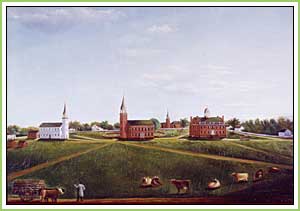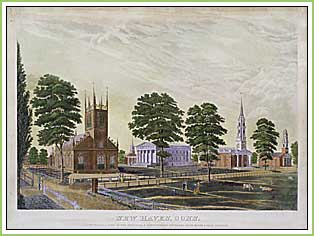
|
 |
 |
 |
 |
|
series of improvements to the New Haven Green indicate that the common was regarded by townspeople as an important asset early in its history. Grass was planted by 1654, and shade trees, including elms and sycamores, were added by the 1750s. Institutional architecture was another attribute: after New Haven was declared co-capital, with Hartford, of the Colony of Connecticut in 1701, the Connecticut State House (1717) was built on the green's northwest side. The common was also the site of the first Yale College building in New Haven, construction of which began in 1717. By 1815 the green had gained the trio of handsome church edifices (all built between 1812-15) fronting Temple Street, which bisects the common. The three churches, looking from left (southwest) to right (northeast) are the Gothic Revival Trinity Episcopal Church and the brick Georgian-style First Church of Christ (Center Church), both by the noted master builder Ithiel Town (1784-1844), and the United Congregational Church.
|
|||||||||||||||||||||||||||||||||||||
Home | GreenLink
| Exhibits | DataCenter
© 2001–2025 TownGreens.com


